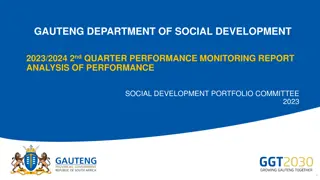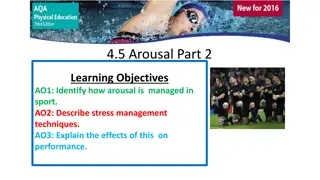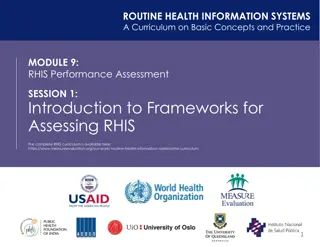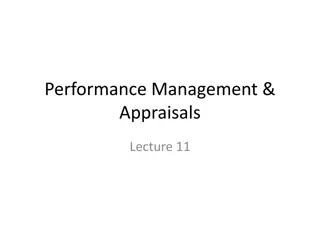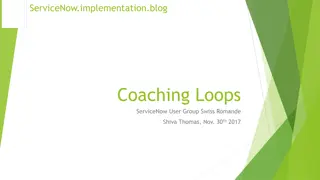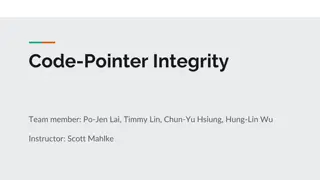Understanding Amygdala Hijack: Impact on Learning and Performance
Exploring the phenomenon of amygdala hijack and its effects on learning and performance, particularly for individuals who have experienced trauma. The module delves into the concept of implicit memories influencing emotions and behaviors, leading to potential disruptions in cognitive processes. By reflecting on personal experiences and understanding triggers, individuals can learn to manage amygdala hijack for improved control and response.
Download Presentation

Please find below an Image/Link to download the presentation.
The content on the website is provided AS IS for your information and personal use only. It may not be sold, licensed, or shared on other websites without obtaining consent from the author. Download presentation by click this link. If you encounter any issues during the download, it is possible that the publisher has removed the file from their server.
E N D
Presentation Transcript
Avoiding Amygdala Hijack: Avoiding Amygdala Hijack: How it Hurts Learning and How it Hurts Learning and Performance and What Performance and What Fast Fish Learners Can Do Fast Fish Learners Can Do Some parts of the brain never forget but remember in ways that we don t have explicit awareness of. The memories can commandeer our emotions, cognition, and physical reactions. This is called the amygdala hijack. It matters for all of us and even more so for people who have experienced trauma. The following pages invite us to consider the experience of amygdala hijack, what it is, and research on what is known about why it happens. It invites you to think about what it means in your own learning and performance. This in turn will help you to think about how you can help learners manage it.
Next Level Lab Users Manual to the Mind This module is part of a set of self-guided courses designed to help people develop a user s manual for their minds. There are seven self-guided courses. 1. Attending to Attention 2. Memory Moves 3. Integrating Emotion, Cognition, and Body Knowledge 4. Active and Deep Processing 5. Building Learning Paths 6. Facing and Leveraging Feedback 7. Maximizing Transfer
This module is part of the Integrating Emotion, Cognition, and Body Knowledge Course. The course includes four modules: 1. Engaging Epistemic Emotions 2. Calming for Concentration 3. Benefitting from Body Knowledge 4. Avoiding the Amygdala Hijack This is the Avoiding Amygdala Hijack Module.
Think about a time when you felt triggered by something that happened and your emotions seemed to be running away with themselves. What was going on? How did your body feel? What happened to your ability to focus and think? Were the feelings negative or positive? If negative, did they in any way invite a fight or flight response in which you felt that you had to defend yourself or flee from the room? In what ways did you feel in control of your response and in what ways did your body seem to be taking control? Take a few minutes to reflect upon what happened in the context and inside your body as a response to what happened.
Here is what other people say: Suddenly I was so filled with emotion that I couldn t think straight and I just wanted to climb under the table. I felt like I was being treated like a child, like I wasn t trusted. I got so mad and I didn t even realize that I was lashing out. People around me were really surprised. The person asked a question in a way that made me feel like he was questioning my knowledge as a female. I started to feel anxious and then smaller and smaller and more and more incompetent. I knew that everyone was depending upon me to pitch the idea, but the more I focused on how important it was for me to do a good job, the less well I could focus on what I was saying. If something like this has happened to you, you have experienced the Amygdala Hijack
Main Ideas: The amygdala is a part of our brain involved in emotional processing. It is considered our lower-level brain and one of the oldest parts of the brain from the perspective of evolution. It is known for our fight or flight response and for tagging memories with emotional salience to enable very quick response. It acts on emotional memories. These are different from memories of emotion (which have a reflective component and involve higher-order processes). A reaction driven by the amygdala can flood our bodies with adrenaline and trigger anxiety before we have a chance to think about what is going on. This is especially so for anyone who has dealt with trauma. Our amygdala can be quickly triggered and does not involve the higher-order portions of the brain, so we have little control over our reaction. Emotional shortcuts can be a source of intuition, but they can also reinforce limiting and maladaptive responses. We can, however, manage the consequences of our amygdala by a series of moves: 1) recognizing the potential for amygdala hijack before it happens; 2) realizing instances when we have been hijacked and having moves that enable us to manage it; 3) adjusting our environments so that we are less likely to be triggered in a way that results in an amygdala hijack.
Think of a memory that you can recall about a time when you had a certain emotion. It can be any type of emotion happy, sad, bored, etc. Try to recall the feeling, what was going on at the time and how you responded. What is the difference between emotional memories and memories of emotion ?
Think of a memory that you can recall about a time when you had a certain emotion. It can be any type of emotion happy, sad, bored, etc. Try to recall the feeling, what was going on at the time and how you responded. What is the difference between emotional memories and memories of emotion ? Having an explicit memory of an emotion means that it is being processed by the higher-order portions of your brain; the part that is called your neo-cortex. You can often tell a story of what happened and remember how you felt.
Think of a memory that you can recall about a time when you had a certain emotion. It can be any type of emotion happy, sad, bored, etc. Try to recall the feeling, what was going on at the time and how you responded. What is the difference between emotional memories and memories of emotion ? Having an explicit memory of an emotion means that it is being processed by the higher-order portions of your brain; the part that is called your neo-cortex. You can often tell a story of what happened and remember how you felt. Then what is an emotional memory and how does it differ? Emotional memories are a part of our lower order brain. We don t have explicit memories of what happened but our brain registers our feelings and uses them to guide future responses.
Think of a memory that you can recall about a time when you had a certain emotion. It can be any type of emotion happy, sad, bored, etc. Try to recall the feeling, what was going on at the time and how you responded. What is the difference between emotional memories and memories of emotion ? Having an explicit memory of an emotion means that it is being processed by the higher-order portions of your brain; the part that is called your neo-cortex. You can often tell a story of what happened and remember how you felt. Then what is an emotional memory and how does it differ? Emotional memories are a part of our lower order brain. We don t have explicit memories of what happened but our brain registers our feelings and uses them to guide future responses. If something frightened us, we may respond with fear or may flee. If something made us happy, we may feel up and not necessarily know why
How do these different memories influence us? Notice that when emotions take the low road to the amygdala, the higher order parts of the brain don t know about them. This leaves us confused and trying to figure out why we are feeling the way we do. Sometimes it is a rush of adrenaline, a spark of anger, or profound sense of discomfort. Emotional Memories take the low road involving the amygdala and our higher-order brain (Neo-Cortex) is unaware of them. It results in physical and emotional responses that our higher-order brain is them left trying to explain. Memories of Emotion are explicit and involve the higher-order brain. We are aware of them and can reflect upon, examine, and think about them.
Even though our higher-order brain doesnt know the source of the feelings, it seeks to explain them after the fact and contributes to our beliefs. Think about a time when you realized that you were feeling anxious and then tried to figure out why? What kinds of explanations did you come up with? What other people say: I started to look at the faces of the people around me and noticed that some of them weren t smiling or looked unfriendly, so I decided it wasn t safe. I decided that these were just not my people. I decided that math is not my thing. I said to myself, Why am I trying to give a speech. I can t do this! I quit my job and decided never to go back.
The role that the amygdala plays is not necessarily negative. It can offer important emotional shortcuts in the form of intuition that help us to act when we need to. Can you think of times when you had an intuition that something just wasn t right? You just had a feeling but didn t know why? You can thank your amygdala for these feelings. It is important to attend to these intuitions and how they relate to what is going on around you.
Amygdala Hijack can be triggered by all sorts of things in our environment. A frown A smell Loud noises A long silence A feeling of hunger An older sibling s off-handed comment A grade on a test A rejection letter What other triggers can you think of? Reach back into your own experiences and those of students or workers that you have engaged with.
Become familiar with the feelings that are triggered by the amygdala by reflecting afterward upon what happens. Try to develop sensitivity to when they are becoming triggered. Recognize that they don t have easy or immediate control over the reaction. Create ways to make space and time for the things that trigger them. Feedback is often triggering for those who have had negative experiences with it. Here are examples of things that people can do to avoid the Amygdala Hijack . Be accepting of oneself when one doesn t perform as one hoped because their amygdala hijacked them. Think about what one might do next time. What are others that you can think of?
Take a few moments to reflect upon your own experiences. Try to come up with an example of when Amygdala Hijack happened. Then think of 3 or 4 things that you could have done to deal with it.
Read this story: For years, scientists studying fish were puzzled. Fish could swim much faster and more efficiently than any of their models could explain. It wasn t until they put the model into water and studied the interaction between the fish and its context that things made sense. They realized that fish create vortices as they move and use these to push off from. Suddenly the performance of fish made sense and scientists understood how fish and their environment interact to enable fast fish ! In what ways might you use the story about fast fish to help you to think about effective learning and work performance?
How can learners and workers behave like the fish? How can we modify contexts for better learning and performance? .Scientists came to realize that fish create vortices as they move to push off from. The fish modified their environment to enhance their performance.
People who learn like fast fish are agentive learners who look for opportunities to adjust things within their environment to help them to do their best learning.
Heres what Fast Fish moves might sound like: I find that my mind wanders when I am trying to study for an exams and I find myself getting pulled into what my housemates are doing. So I now tell them in advance when I am going to study and for exactly how long. I ask them to ignore me until that time is up and not to talk to me even if I wander out where they are. Fast Fish-style generative moves focus on modifications to the surrounding contexts that can improve, thinking, learning, and performance. I realized that moving my desk into a corner gave me control over when I needed to focus and when I was ready to be social. I had to navigate fewer sticky situations and got more work done.
Research on the teaching of thinking and learning has focused on what skills learners have and how they can modify their actions. Here, we are shifting to a focus on what skills learners have, how they can modify their actions and how they can modify their context to support good learning and performance. We call this Fast Fish Learning
Here is an example from Workforce Development. Read this story about Jaylen. In what ways is he behaving like a fast fish? Jaylen is hitting his stride in his new job as a computer programmer for a shipping company. His manager, Devon, gave him the opportunity to rearrange the workspace so he has better access to the data and people he needs to interact with. Recently, he realized that Devon doesn t know the details of the job the way that he does. In fact, Devon prefers that Jaylen comes to him with proposed solutions to problems that they discuss together. Jaylen also knows, that like many people who have experienced trauma at some point in their lives, it helps him to absorb feedback over time before responding. He asked Devon to give feedback on his work performance that incorporates this delay whenever possible. Jaylen found that it helps him to be open-minded towards feedback and to use it well.
What is working in the example of Jaylen? What makes his success possible? How can we create ways for learners to become agentive, engaging their whole selves, and managing the contexts around them to enhance their learning and performance?
Here is an example from a fourth Here is an example from a fourth- -grade classroom. Read this story about Annika. In what ways is she behaving like a fast story about Annika. In what ways is she behaving like a fast fish? What other advice might you have for her? fish? What other advice might you have for her? grade classroom. Read this Annika likes to get all of her work done during the school day. Her school has a learning contract that means if you get your work done during the day, you won t have any homework. Things were going well until Sophie befriended her. Sophie is working on self-control and constantly interrupts Annika s thought processes. Annika has tried to get Sophie to realize that she can t keep interrupting but also realizes that Sophie is trying and has significant attentional challenges. Annika decides to talk to the teacher to consider what to do. They consider a couple of things. Realizing that some stimuli grab attention even when one is trying to focus, the teacher and Annika decide to create a study carrel in an old closet so that it is harder to disrupt her attentional focus. The teacher promises to give more support to Sophie when Annika is trying to focus. Annika offers to make sure that she is spending a good amount of time with Sophie during social moments so that Sophie might feel less needy of her attention when Annika wants to focus.
Heres what Fast Fish moves might sound like: I realize that, like many people who have experienced trauma at some point in their lives, it works better for me to absorb feedback over time before responding. I asked my manager to give feedback on my work performance that incorporates this delay whenever possible. This helps me to be open-minded towards feedback and to use it well. Now let s turn back to Amygdala Hijack. Consider the possible strategies. We often try to focus on what one can change internally. What would it sound like to create Fast Fish moves that change the surrounding environment to deal with Amygdala Hijack? I knew that I would have a hard time giving the final presentation, so I told the other students that I felt that way and asked them to smile when I was speaking. They did and I gave a much better talk.
Recall the example that you thought about from your own experiences involving Amygdala Hijack. Can you think of a few things that you could have done to modify the environment to deal with it?
Help fellow students, work colleagues, and others to realize that we all have amygdala triggers and that accommodating them make the workplace a more productive, deliberately developmental environment. Look for ways to change the workplace or school to accommodate your personal triggers. For instance, ask for time between the receipt of feedback and your response. Here are examples of Fast Fish Moves to Avoid the Amygdala Hijack : Look for ways to systematically remove triggers if possible. (Microaggressions can be a form of trigger. Reflection on such triggers in the workplace can support diversity, equity, and inclusion.) What are others that you can think of?
Read this story about Camila. What advice Read this story about Camila. What advice might you have for her to help her to manage might you have for her to help her to manage amygdala hijack like a fast fish? amygdala hijack like a fast fish? Camila enjoys her new school most of the time. She works hard to do what ever the teacher asks her to do. It is much harder though when the teacher asks her to figure out things on her own. What if she gets something wrong? In her old school she would get in trouble if she did something that the teacher didn t want her to do. Living with her uncle who criticized everything meant she really needed to avoid trouble in school. She can see that her new teacher is very nice but seems puzzled when Camila backs down from challenges and turns inward. If her teacher pushes her, she gets really flustered and withdraws completely. It feels out of her control and not something that she can do anything about. This Photo by Unknown Author is licensed under CC BY-SA
In Summary: The amygdala can exert a lot of control over our behavior and because it does not involve the higher- order portions of the brain, we have little control over our reaction. Emotional shortcuts can be a source of intuition, but they can also reinforce limiting and maladaptive responses. Therefore, dealing with our amygdala can be challenging. As learners, we need to figure out how to manage ourselves and our environments to avoid the worst consequences of an amygdala hijack and to make the most of situations in which it guides our intuitions towards important information. In the workplace and school, we can be aware of how people respond due to amygdala hijack and to support them in managing their emotional memories, traumas, and reactions. This includes: 1) recognizing the potential for amygdala hijack before it happens; 2) realizing instances when people may have been hijacked and supporting them rather than judging them. 3) helping them to develop moves to manage when it happens and creating malleability in workforce environments to help them to navigate the way that their amygdala interacts with their responses.





